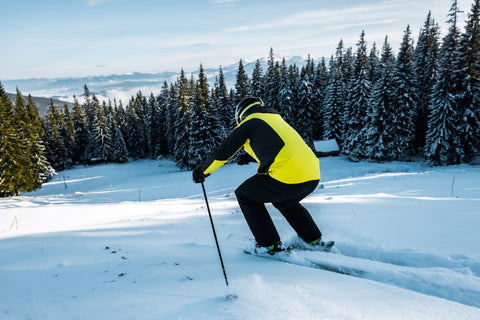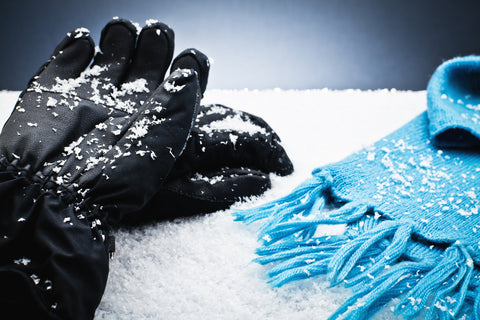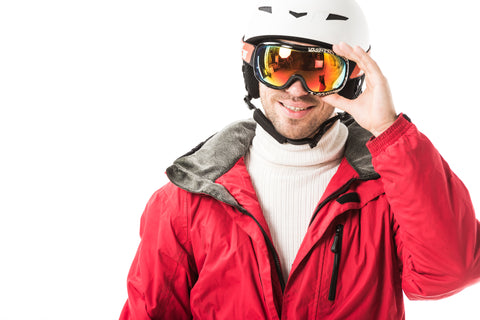Layering is an important aspect of staying warm and comfortable while skiing in cold weather. By layering your clothing, you can easily adjust to changes in temperature and activity level, and remain comfortable throughout the day. In this guide, we'll provide tips on how to layer up for skiing, including what to wear and how to access additional layers as needed.
Layering Up Guide - Ski Layering System
Base layer: The men's base layer is the foundation of your cold-weather clothing system. It should be made of moisture-wicking fabric, such as merino wool or synthetic materials, and should fit snugly against your skin.
This layer helps to keep you dry by wicking away sweat, which can make you feel cold and uncomfortable if it accumulates on your skin.
Choose a women's base layer that is breathable and comfortable, and avoid materials that are too thick or bulky, as they may restrict your movement on the slopes.
Insulating layer: The insulating layer is designed to trap heat and keep you warm. It should be made of a material that is lightweight, yet warm and breathable.
Some options include fleece or down jackets.
The insulating layer should be worn over the base layer and should fit comfortably, but not too tightly.
Avoid materials that are too bulky or constricting, as they may interfere with your range of motion while skiing.

Shell layer: The shell layer is the outer layer of your clothing system and is designed to protect you from the elements. It should be waterproof and windproof and made of a durable material such as Gore-Tex.
A ski jacket and pants made from this type of material will help to keep you dry and warm on the slopes. Choose a shell layer that is appropriately sized and not too tight or too loose. It should allow for good mobility and ventilation and adequate protection from the cold and wet. Other important layers: Don't forget to layer up on your hands, feet, and head. Wear a warm hat, gloves or mittens, and socks made of moisture-wicking fabric.
Make sure to bring extra layers in case you get cold or wet, and adjust your layers as needed throughout the day to maintain a comfortable body temperature. Pay attention to your extremities, as they are more prone to getting cold and can affect your overall comfort while skiing.
Access to additional layers: It's also a good idea to bring a backpack with you on the slopes, so you can easily carry and access additional layers if needed. This way, you'll be prepared for any changes in the weather or if you start to feel too cold or hot. Consider packing an extra base layer, insulating layer, and shell layer in your backpack, as well as a spare pair of gloves, socks, and a hat. This will give you the option to add or remove layers as needed throughout the day.
Overall, layering is an important aspect of staying warm and comfortable while skiing in cold weather. By following these tips and choosing the right layers, you'll be well-equipped to handle the elements and enjoy your time on the slopes.
Choosing the Right Base Layers for Cold Skiing
When layering up for cold skiing, it's important to start with a base layer that will keep you dry and comfortable. The best base layers are made of moisture-wicking materials like synthetic fibers or merino wool, which will help to draw sweat away from your skin and prevent you from getting chilled. Look for base layers that are lightweight and stretchy, as these will be more comfortable to wear under your other layers. Avoid cotton base layers, as they tend to retain moisture and can make you feel cold and clammy.
Adding Insulation with a Mid-Layer
Once you have your base layer sorted, it's time to add some insulation with a mid-layer. This could be a fleece or down jacket, or any other type of warm, insulating layer. The key is to find something that is lightweight and flexible, so it won't restrict your movement while you're skiing. You may want to consider a layer with a zipper or vents, so you can adjust the ventilation as needed.
Protecting Yourself from the Elements with an Outer Layer
Your outer layer is the final line of defense against the cold, wind, and snow. This should be a waterproof and windproof layer that will keep you dry and protected from the elements. A ski jacket and pants are ideal for this purpose, as they are specifically designed for cold, wet conditions. Look for a jacket with a hood and plenty of pockets for storing your gear, and make sure your pants have reinforced areas at the knees and seat for extra durability. Don't forget to add a pair of waterproof gloves and a warm hat to complete your outer layer.
Keeping Your Head and Ears Warm with a Hat and Neck Gaiter
Your head and ears are some of the most sensitive areas when it comes to cold weather, so it's important to protect them well. A hat or beanie will help to keep your head warm, and a neck gaiter or scarf can be used to cover your ears and lower face for added protection. Look for hats and neck gaiters made of insulating materials like fleece or wool, and consider adding a face mask or balaclava for extra warmth.
Staying Warm and Comfortable with the Right Gloves or Mittens
Your hands are another important area to consider when layering up for cold skiing. You'll need a pair of gloves or mittens that are insulated and waterproof to keep your hands warm and dry.

Look for gloves with a good fit and plenty of flexibility, as you'll need to be able to grip your ski poles and perform other tasks without feeling restricted. If you tend to get really cold hands, consider using hand warmers or chemical heat packs to add extra warmth.
Wearing Warm, Insulated Boots and Socks
Your feet will be subjected to a lot of cold and wet conditions while skiing, so it's important to invest in a good pair of warm, insulated boots and socks. Look for boots with a waterproof and breathable membrane, as well as a good amount of insulation and sturdy construction. Socks should be made of moisture-wicking materials like wool or synthetic fibers and should be thick enough to provide cushioning and insulation. Don't forget to pack a spare pair of socks in your ski bag.
Layering Up Your Lower Half with Thermal Leggings or Long Johns
Finally, don't forget about your lower half when layering up for cold skiing. A good pair of silk or merino thermal leggings or long johns will help to keep your legs warm and toasty, even in the coldest conditions. Look for leggings or long johns made of insulating materials like fleece or wool, and consider adding a pair of gaiters to your ski pants to keep snow out of your boots. As with all your other layers, it's important to find something that is comfortable and allows for plenty of movement.
Conclusion
Layering is an important aspect of staying warm and comfortable while skiing in cold weather. By following these tips and choosing the right layers, you'll be well-equipped to handle the elements and enjoy your time on the slopes. Remember to bring extra layers and pay attention to your extremities, and you'll be set for a comfortable and enjoyable day on the slopes.
Questions and Answers
Why is layering important for cold skiing?
Layering is important for cold skiing because it allows you to easily adjust to changes in temperature and activity level. By wearing multiple layers of clothing, you can add or remove layers as needed to maintain a comfortable body temperature. Layering also helps to trap heat and protect you from the elements, such as wind and moisture.
What should I wear as a base layer for cold skiing?
A base layer for cold skiing should be made of moisture-wicking fabric, such as merino wool or synthetic materials. It should fit snugly against your skin and help to wick away sweat as you ski.
Choose a base layer that is breathable and comfortable, and avoid materials that are too thick or bulky, as they may restrict your movement on the slopes.
What should I wear as an insulating layer for cold skiing?
An insulating layer for cold skiing should be made of a material that is lightweight, yet warm and breathable. Some options include fleece or down jackets.
The insulating layer should be worn over the base layer and should fit comfortably, but not too tightly.
Avoid materials that are too bulky or constricting, as they may interfere with your range of motion while skiing.
What should I wear as a shell layer for cold skiing?
A shell layer for cold skiing should be waterproof and windproof and made of a durable material such as Gore-Tex
What should I wear on my hands, feet, and head for cold skiing?
You should wear a warm hat, gloves or mittens, and socks made of moisture-wicking fabric for cold skiing. Pay attention to your extremities, as they are more prone to getting cold and can affect your overall comfort while skiing. Make sure to bring extra layers in case you get cold or wet, and adjust your layers as needed throughout the day to maintain a comfortable body temperature.

Should I bring a backpack with me on the slopes for cold skiing?
It's a good idea to bring a backpack with you on the slopes for cold skiing, as it allows you to easily carry and access additional layers if needed. Consider packing an extra base layer, insulating layer, and shell layer in your backpack, as well as a spare pair of gloves, socks, and a hat. This will give you the option to add or remove layers as needed throughout the day.
ABOUT THE AUTHOR
Fred Felton
Content Creator / Editor
Fred Felton is a copywriter, editor and social media specialist based in Durban, South Africa. He has over 20 years of experience in creating high end content. He has worked with some of the biggest brands in the world. Currently Fred specialises in the winter outdoors space, focussing on skiing and snowboarding. He is also a keynote speaker and has presented talks and workshops in South Africa.






